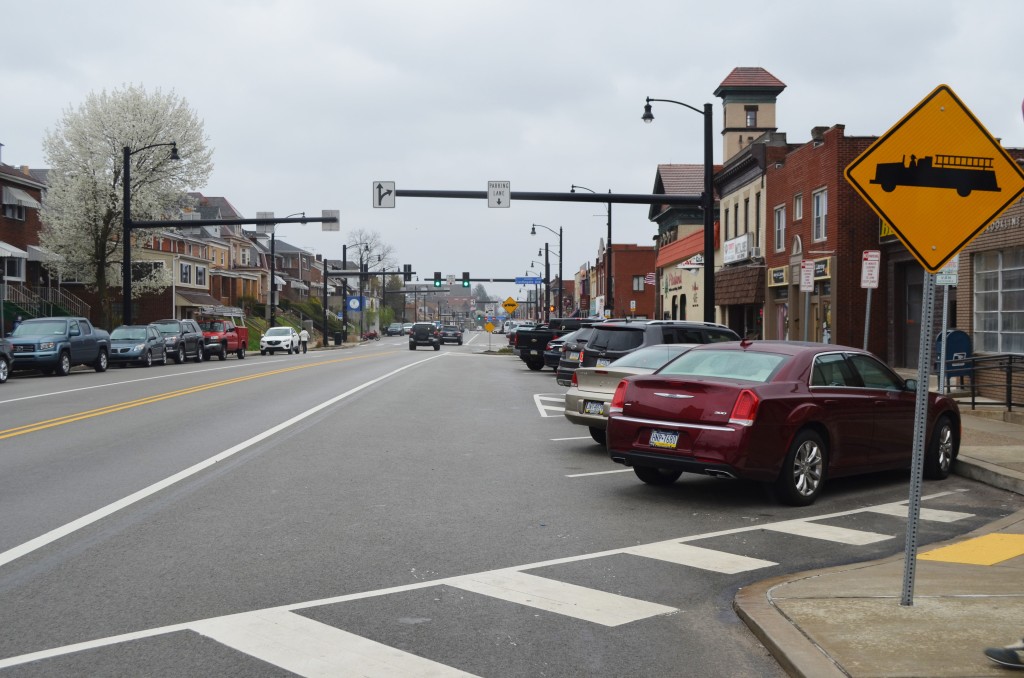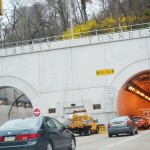Boulevard revitalization key to town’s success

The Brookline Boulevard Revitalization Program allowed for smoother paved concrete and new head-in parking along the main street. Photo by Rebekah Devorak.
By: Rebekah Devorak and Claire Murray
Brookline Boulevard looks much different today than it did just three years ago with its wide-sweeping sidewalks, ample angled parking and smoothly paved roads.
Back in 2012, before the Brookline Boulevard Revitalization Program kicked off, the Boulevard’s many obstacles were testimony to the town’s rich history. It had the widest main street in Pittsburgh, with two sets of trolley tracks lining the Boulevard in addition to pavement for automobiles and space for head-in parking.
In order to know Brookline’s future, it is important to understand its history.
Painter and business owner Robert Daley has lived in Brookline for all 65 years of his life. In fact, his parents were among the first to settle the town in the early 1900s when it was still farmland. He distinctly remembers the Boulevard’s early days and even created a replica of the red and white trolleys that ran through his town.
“We used to ride into town or go down to Forbes Field to see sporting events,” Daley recalls, adding that the ride cost only a nickel.
Brookline residents were not the only ones using the trolleys. The town’s thriving stretch of small businesses attracted consumers from all over the city to travel into the suburban shopping district.
Brookline lost its trolley transportation in 1968 as more people turned to malls for shopping, although the streetcars still ran through neighboring towns such as Dormont and Beechview. For the decades that followed, the unused tracks rendered the roads bumpy and uneven. Overhead electrical wires appeared haphazard, making the rows of business look crowded rather than charming.
It was time for a change.
“The revitalization was huge for Brookline,” Nathan Mallory, former owner of Cannon Coffee and current president of the Brookline Chamber of Commerce, says. “It was really in need of a change.”
The change that Brookline desperately needed, though, almost didn’t happen.
Originally, representatives from the City of Pittsburgh proposed design plans for reconstruction of the Boulevard back in spring of 2000. However, the project abruptly halted and never moved beyond sketches due to a financial crisis in the city. But in 2008, the Brookline Chamber of Commerce suggested the plans again.
After securing the funding for the $5.35 million project, construction workers broke ground on the half-mile main street on Feb. 23, 2015. Throughout the 18 months of construction, workers poured new concrete sidewalks on both the business and residential sides of the Boulevard, installed new traffic signals, paved the existing road and added new streetlights and parking meters, among a slew of other improvements.
While Brookline residents’ daily commutes were hindered by the ensuing roadwork, the business owners on the Boulevard took the hardest hit. Large wire fences guarding construction zones blocked the entrances of almost every store. The roadwork made parking nearly impossible. The revitalization process deterred the flow of customers that sustained the town’s small businesses.
“Cannon Coffee lost over $80,000 in revenue over the 18-month construction period,” Mallory says. “It’s humbling to still be around.”
In an effort to rejuvenate the local businesses along the Boulevard, the community began to preach a “three/50” mentality. Brookliners are encouraged to spend $50 three times a month at their favorite hometown stores to help sustain them.
Geri Roberts, owner of 824 Consignments, loves shopping in the neighborhood stores on the Boulevard. “I sold my car,” Roberts says. “I don’t need it. I can get everything I need right here on the Boulevard. I threw a fabulous holiday dinner for my family last year, and I purchased everything for it right here.”
“It’s so awesome to see people come out and support the small businesses,” Mallory says. “That’s what makes it worth it. We are a unique business district, full of mom-and-pop shops. It was really difficult to get to the Boulevard, with no real parking or sidewalks for 18 months. But [the businesses] are around because the community values them. That’s what makes our town the greatest neighborhood in Pittsburgh. There’s a sense of security, access – it’s an easy neighborhood to live in.”
Daley, who has witnessed all of Brookline’s highs and lows in the past half-century, praises the promising leadership that Mallory brings to Brookline.
“The main thing that he brought was a youthful kind of atmosphere and energy to the Boulevard that hasn’t been there for a long time,” says Daley, specifically noting Mallory’s coffee shop and housing initiatives that target university students and young families.
Despite its harsh years of revitalizing construction, Brookline Boulevard is currently home to about 80 small businesses, three churches and a row of residential housing. The town’s demographic is slowly shifting as several organizations in the town offer services to a growing population of resettled refugees.
Although many great changes have come to the wide, half-mile stretch of the Boulevard, Brookline adapts to its many obstacles and will continue thrive as the place of culture and entrepreneurial success that it has always been.
 Previous Post
Previous Post Next Post
Next Post